From undergraduate students to experts with nearly 50 years of experience, Michigan Technological University researchers know snow. In Tech's College of Engineering, five researchers make the most of the University's snowy locale, where snow and engineering go hand-in-hand.
Located in the snow globe known as the Keweenaw Peninsula, Michigan Tech and the surrounding area receive annual snowfall averaging about 220 inches. From local ski hills to snowmobile trails through town, Huskies embrace these wintry conditions. For five Michigan Tech researchers, snow is more than just part of their everyday lives in Michigan's Upper Peninsula; it's an integral aspect of their research and scholarly pursuits.
There are as many different kinds of snow research as there are different types of snow. Michigan Tech engineers are studying how snow reflectivity is keeping our planet cool. They're also using predictive models to forecast lake-effect snow storms at the end of the century, developing techniques to increase solar panel efficiency in snowy climates, making pavement out of snow itself in the Antarctic, and analyzing how lake-effect storms interact with our local region.
Snow Reflectivity's Global and Local Impact
Alden Adolph, assistant professor of engineering fundamentals and mechanical and aerospace engineering, may be new to Michigan Tech, but she's no stranger to snow. Adolph, who joined Michigan Tech's College of Engineering in fall 2024, said she came to Tech looking for the infamous amounts of snowfall.
About the Researcher
"I am excited to be working at Michigan Tech in Houghton, which is known as one of the snowiest places in the country," said Adolph. "I feel really lucky to be able to do my research here."
With her new snow research team at Tech, Adolph studies snow albedo, also known as sunlight reflectivity.
"All surfaces have an albedo, or how much incoming sunlight is reflected off of the surface," said Adolph. "What's cool about snow is that it has a very high albedo, one of the highest albedos of natural surfaces on the Earth. That has some interesting effects because the sunlight is reflected off the snowpack instead of being absorbed, which allows that snow to stay cool."
While surfaces with a high albedo reflect sunlight and keep our planet cool, surfaces with a low albedo, like rocks or water, absorb sunlight and warm up. Snow's albedo does more than just keep itself cool; the albedo of snow and ice around the globe also helps keep our planet cool and regulate our climate.
Adolph's research specifically studies how various properties of snow affect its albedo.
"As the people of Houghton will know well, there are all varieties of snow," said Adolph. Snow grain size, freshness and the presence of impurities can all affect snow's albedo. What Adolph and her team are currently studying is how the melting of snow affects its albedo.
"We're pretty sure it's an important factor and often it's indirectly accounted for, so our work is looking fundamentally at how the presence of water in a snowpack affects its albedo," explained Adolph.
Fieldwork for Adolph and her team of four undergraduate students this semester consists of measuring the snow's albedo, grain-size, impurities and liquid water through the spring as the snow melts.
Adolph is excited to be working with students who are as passionate about snow as she is.
"When I started looking for undergraduate students to participate in my research, I was thrilled to see how many students were eager to get involved in snow research. They were excited to dig snow pits and ready with their snow gear. At Michigan Tech, you're working with students who are enthusiastic about snow."
The research Adolph and her team are conducting can also help predict how and when the snow is going to melt at the end of the season — information with global and local implications.
"This kind of research can be important in places where snowmelt is the predominant source of drinking water or water for irrigation," said Adolph. "In places like the mountainous west of the U.S. or in the Himalayas, they rely on snowmelt for their water, so figuring out when the snow is going to melt is critical. Studying snowmelt can be important for a local community as well as when considering a global response to climate change."
Lake-effect Snow Storms of the Future
Miraj B. Kayastha's interest in understanding how global climate change affects regional climate systems led him to Michigan Tech, where he is currently a civil engineering Ph.D. student.

"The opportunity to engage in large, multi-institutional projects focused on improving our predictive understanding of the Great Lakes' climate systems was particularly appealing," said Kayastha. "Michigan Tech offers a unique combination of cutting-edge resources, collaborative research, and a focus on this vital region, making it the ideal place for my research."
Kayastha was also excited for the opportunity to study with Pengfei Xue, professor in the Department of Civil, Environmental, and Geospatial Engineering, associate director of Michigan Tech's Great Lakes Research Center (GLRC) and pioneering researcher in regional climate modeling.
When focusing on regional climate systems, Kayastha became interested in the Great Lakes.
"As the largest unfrozen surface freshwater system in the world, the Great Lakes are uniquely sensitive to climate warming," said Kayastha. "Studying how climate change influences this region over time is truly captivating."
Last year, Kayastha, Xue and researchers from the GLRC, with collaborators from the Argonne National Laboratory and Pacific Northwest National Laboratory, published a study on the effect of future climate conditions on lake-effect snow storms.
Lake-effect snow storms are caused when cold, dry air passes over warmer lake water, absorbing moisture and generating heavy snowfall. While Michigan Tech is known for its abundant lake-effect snow, Kayastha and his fellow researchers focused on a record-breaking snow storm that dropped nearly two meters (close to six and a half feet!) of snow on Buffalo, New York, on the eastern shore of Lake Erie in November 2022.
Using the data from the Buffalo storm, Kayastha and his fellow researchers used an advanced regional climate model to simulate the same storm in projected climate conditions in the middle and late 21st century. The results, which were recently published in Forbes, forecasted a 14% precipitation increase due to end-of-century warming. This increase also showed a shift in precipitation type, transitioning from mostly snowfall to nearly equal parts snow and rain.
"More importantly, this shift from snowfall to rainfall was found to nearly double the area experiencing another winter hazard: rain-on-snow," said Kayastha. Rain-on-snow is an increasingly prevalent hazard as precipitation levels are affected by climate change — it can cause damage to infrastructure and flooding.
The multi-institutional study, a part of the COMPASS Great Lakes Modeling project, provides a plausible future storyline for lake-effect snow storms in Buffalo. The research team focused on "understanding the intricate interplay between atmospheric and lake warming in shaping the future dynamics of lake-effect snow storms," said Kayastha.
Snow on the Roads vs. Roads Made of Snow
Driving through snowy conditions can make even the most skilled driver nervous. Russ Alger '80 '81 welcomes the challenge. With almost 45 years of experience, 39 of those years spent as the director of the Institute of Snow Research (ISR) with Michigan Tech's Keweenaw Research Center (KRC), Alger is an expert on cold climate roads and driving.

As a lifelong resident of the Keweenaw Peninsula, snow practically runs in Alger's blood. His father George was a civil engineering professor at Michigan Tech, specializing in ice-covered rivers and cold regions engineering. Alger earned his bachelor's in civil engineering from Michigan Tech, as well as his master's in cold regions engineering, a program his father helped start.
"Growing up in nearby Dollar Bay and working with my dad on outdoor projects, as well as being an outdoorsman myself, pointed me down that path at a young age," said Alger.
As ISR director, Alger has overseen projects in snow mobility, pavement development, winter road maintenance, anti-icing, de-icing and more. Home to a vehicle test course covering more than a thousand acres, the ISR has become the headquarters for winter mobility research for vehicles from U.S. Army tanks to snowmobiles. In recent years, as the KRC has focused on off-road autonomous vehicle operation, Alger has also assisted in helping the vehicles to characterize soil and snow in the terrain to better avoid obstacles.
"The unique weather conditions on Michigan's Keweenaw Peninsula, coupled with our large array of equipment and facilities, makes the institute the right place to bring your research questions," said Alger.
In addition to his work in mobility testing, Alger holds a patent on a method he invented to manufacture pavements made entirely from snow. The process uses a snow paver that works by mechanically altering the internal snow properties and developing high strengths in the snow pack.
Alger traveled to Antarctica six times as part of a team that successfully scouted and created the first trail to the South Pole, a necessary alternative to flying in supplies. Fifteen miles of that trail were paved using Alger's snow paver, which converted snow into solid roadway.
"The paver works by first chewing up the snow with a miller drum, which smashes the ice crystals so they will stick together," explained Alger. "Then comes a vibrating compactor, to get all the air out of the snow. That action compresses it enough to make a pavement."
Alger also developed SafeLane, an epoxy-aggregate mixture widely used to improve traction and safety on roads, bridges, walkways and parking lots during hazardous winter conditions.
The Keweenaw Peninsula has proved to be a prime location not only for the Institute of Snow Research, but also for Alger. "Growing up in the Copper Country helped to make me like snow for sure," he said.
Adapting Solar Power for Extreme Winter Climates
Ana Dyreson understands that the lessons we learn in extreme snow can be beneficial to other locations that receive far less snow per season. Dyreson is an assistant professor of mechanical and aerospace engineering and the associate research director for Michigan Tech's Center for Innovation in Sustainability and Resilience (CISR), and also leads the Great Lakes Energy Group. Dyreson collaborates on several climate- and energy-focused projects, including studying photovoltaic (PV) technology — commonly known as solar panels — at the Michigan Solar Regional Test Center (RTC).
About the Researcher
The U.S. Department of Energy designated facility is headquartered at Michigan Tech's Advanced Power Systems Research Center and is the northernmost facility of its kind, allowing Dyreson and her team to investigate ways to improve PV system operation in cold and snowy climates.
"Solar in the Upper Peninsula is not new," said Dyreson. "During the winter, the snow will reduce performance, and utility rate agreements vary, but solar systems will generate electricity that will offset your electricity costs to some extent over the year. Our research is about how to reduce those wintertime losses."
While PV technology has grown in popularity for individual homes and businesses, about 65% of solar capacity in the U.S. is utility-scale, like the facility here at Michigan Tech. At these large solar facilities, solar arrays are either fixed in one position or equipped to track sunlight through the day on single- or double-axes. Regardless of array type, when snow covers a large solar power plant it is difficult and impractical to remove the snow, leading to snow shading — where enough snow gathers on PV panels to stop them from generating electricity.
In collaboration with Ayush Chutani, a member of the Great Lakes Energy Group and a mechanical engineering Ph.D. candidate advised by Dyreson, the research group is trying to figure out how single-axis arrays can change positions to capture the most sunlight as well as shed snow buildup on the panels.
By using a system of snow sensors, the researchers are developing new algorithms for smart controls to adjust single-axis tracking arrays before, during and after snow buildup. Dyreson and Chutani must also consider the effects of factors like wind speed, wind direction and temperature on snow buildup and shed timing — but their research could increase the electrical power output of PV technology under near-constant snowy conditions.
Understanding solar technology resiliency and efficiency in extreme winter conditions experienced at Michigan Tech and in the surrounding Keweenaw Peninsula will also be beneficial to solar technology present in warmer, temperate climates that receive less snowfall.
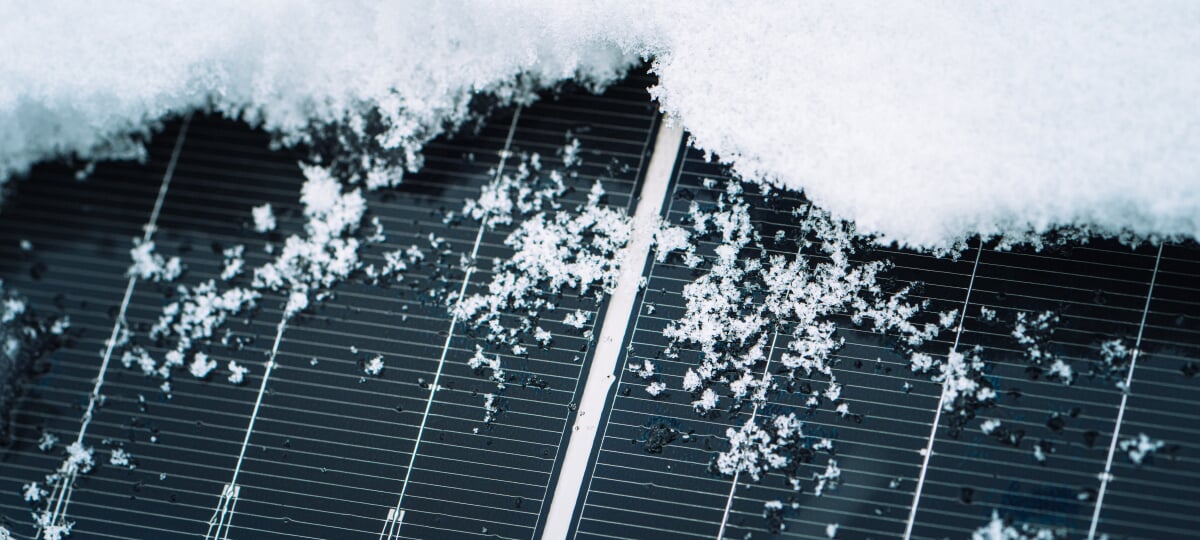
"Improving PV system operation in cold climates improves cost-effectiveness and ultimately addresses one of the biggest challenges in climate change and sustainability: reducing the carbon intensity of electricity supply," said Dyreson. "The hardy and enterprising mindset that we apply to solutions — as well as life in the Keweenaw — serves us well as we take on this task."
A Planetary Atmospheric Scientist's Love for Lake-effect Snow
Shawn Brueshaber is drawn to lake-effect snow the same way others are drawn to chasing tornadoes and severe thunderstorms. "It is the raw power of nature," explained Brueshaber. "Lake-effect snow can be relentless and amazing, and here in the Keweenaw Peninsula we can expect it. Most winters, that is."
Brueshaber has always liked snow. The mechanical and aerospace engineering assistant professor grew up in Maryland, where the occasional nor'easter storm would bring a blizzard with thundersnow. "I've seen 30-plus inches of snow in less than 24 hours out of one of these storms," said Brueshaber. "My hometown, a few years ago, got 42 inches in about 28 hours!" Brueshaber has memories of school closing for a week and sledding until he was too tired to walk back uphill.
About the Researcher
Brueshaber's interest in unique weather phenomena led him further than one might expect. At Michigan Tech, he is a planetary atmospheric scientist researching the convection and storm dynamics of the solar system's giant planets: Jupiter, Saturn, Uranus and Neptune. He uses data acquired from the Hubble Space Telescope, NASA's Infrared Telescope Facility, and from four instruments onboard the Juno spacecraft, which is currently orbiting Jupiter.
While studying atmospheric dynamics of giant planets might seem too out of this world for some, Brueshaber studies similar atmospheric dynamics on the local level as well.
On Earth, he is exploring how lake breezes impact air quality and lake-effect snow, and collecting cloud, precipitation and aerosol data for long-term monitoring in the Keweenaw. His Planetary Atmosphere Works (PAWs) Lab has installed three new instruments at the KRC to help observe clouds, aerosols and precipitation.
Recently, with the help of several undergraduate and graduate students, Brueshaber began building and testing a low-cost radiosonde, a battery-powered instrument that measures atmospheric conditions. Attached to a weather balloon, a radiosonde is carried high into the atmosphere, transmitting data such as temperature, humidity, pressure, wind speed and wind direction back to earth for use in forecasting.
Brueshaber is also working to determine how wind flow over the Keweenaw affects snowfall locally, as well as downstream into the central and eastern Upper Peninsula — a project spawned by conversations with the National Weather Forecast Office in Marquette, Michigan. Forecasters have noticed that lake-effect snow often forms a dominant band of precipitation as it moves over the Keweenaw Waterway near Michigan Tech's campus. Brueshaber plans to conduct a systematic analysis to better understand how this pattern affects snowfall in communities that lie southeast of the Keweenaw Peninsula, like Marquette and Munising.
Adding to the fleet of remote sensing weather instruments, Brueshaber is also working to outfit a quadcopter and a fixed-wing drone with in-situ weather sensors.
"Michigan Tech is one of the few universities in our state that is actively growing and located in a cold-weather region suitable for researching winter weather," said Brueshaber. "The Keweenaw is perfect for expanding our understanding of winter storms."
Michigan Technological University is an R1 public research university founded in 1885 in Houghton, and is home to nearly 7,500 students from more than 60 countries around the world. Consistently ranked among the best universities in the country for return on investment, Michigan's flagship technological university offers more than 185 undergraduate and graduate degree programs in science and technology, engineering, computing, forestry, business, health professions, humanities, mathematics, social sciences, and the arts. The rural campus is situated just miles from Lake Superior in Michigan's Upper Peninsula, offering year-round opportunities for outdoor adventure.
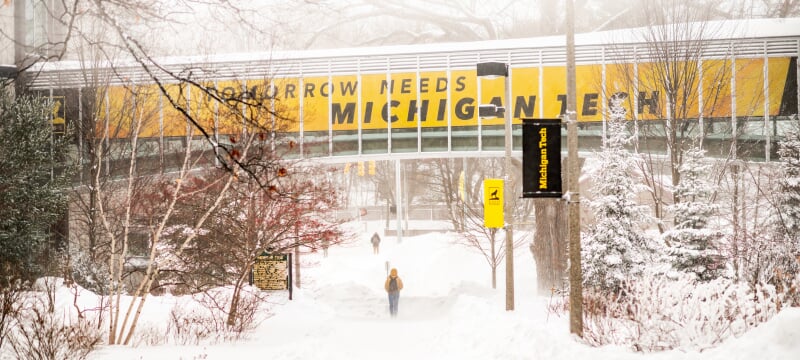
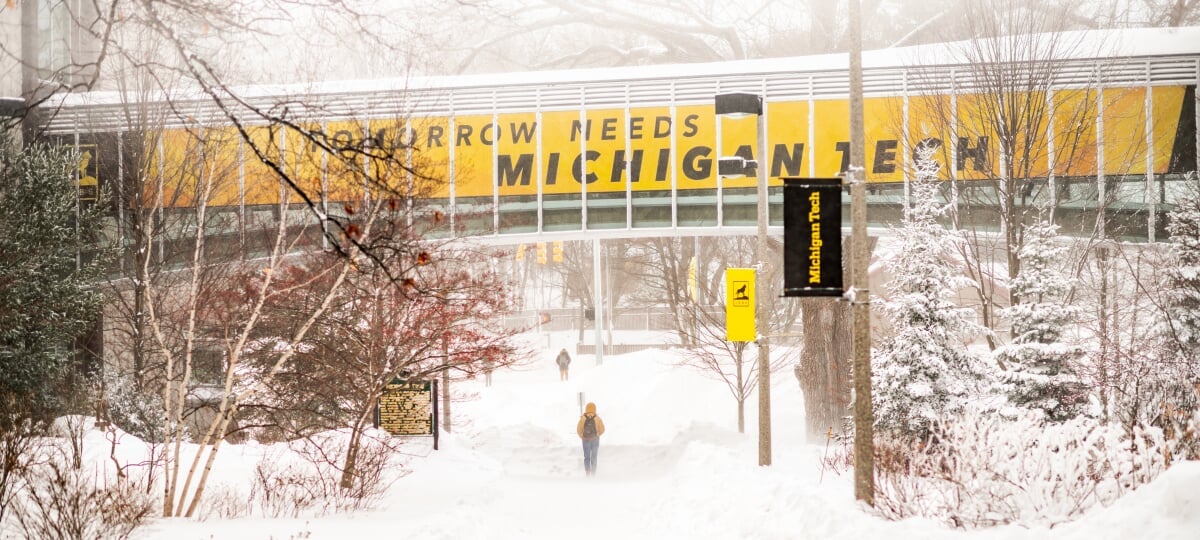





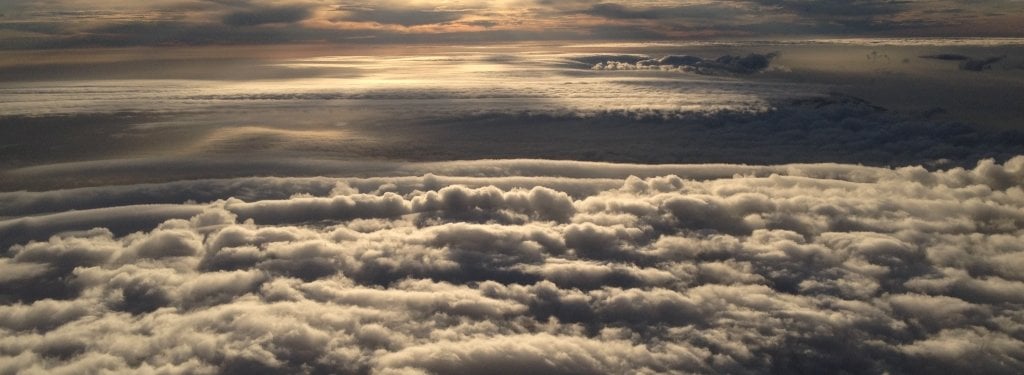
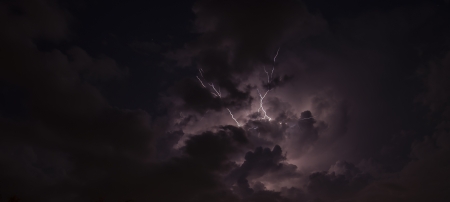
Comments